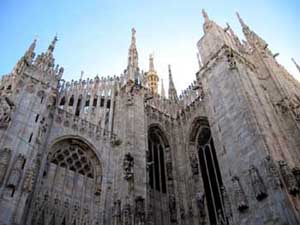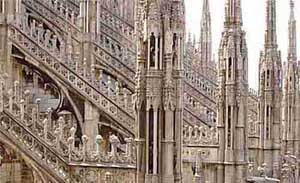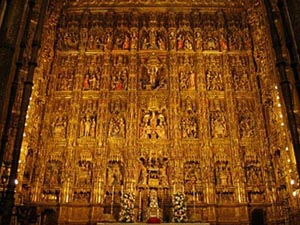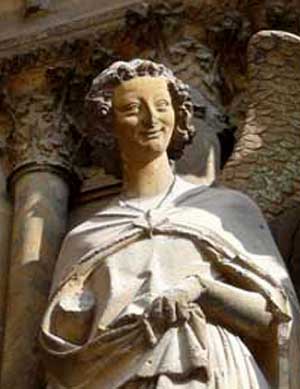 |
Art & Architecture
‘Reading’ Medieval Architecture
Christine Fitzgerald
Architecture is one of the expressions of a nation’s soul. When someone wants to truly understand an era in History, he almost invariably studies the architectural styles of that time. This usually leads to the study of the Middle Ages, which give a base line to understand other eras by comparison. I believe that never before or since has there been an era so rich in beauty or as replete with symbolism as that time.

The intricately carved Cathedral of Milan that soars high toward Heaven; below, a detail

|
Everything in medieval architecture reflected the hierarchical order of the society on which it was constructed - the detailed and complex relationships connecting lines, arches, vaults and buttresses analogized the multifaceted interdependency of secular, ecclesiastical and familial authority – bellatores, oratores and laboratores (those who fight, those who pray and those who work). It was a hierarchical society where, each part in its turn, followed God’s plan in creation.
The buildings themselves were made of rock, showing their strength to resist the inclemency of the weather and the wearing away of the centuries. They reflected the timelessness and unchangeableness of the Catholic Faith, which inspired those edifices in the countries that made up Christendom.
The cathedrals, the pearls of medieval architecture, were usually tall, supported by Romanesque or Gothic arches. The latter allowed those building to reach unheard of heights. To fill the large spaces in the walls, the more refulgent stained glass windows were created. The building’s great height, combined with the astonishing polychromic display of light coming from the stained glass windows, give one the impression that, although his feet are on earth, he could ascend to heaven by praying silently there or assisting at the beautiful ceremonies of the Church.
The plans of medieval churches were often in the shape of a cross, a homage to Our Lord’s death. Beneath the intersection of the two naves of the cross, the main altar was placed to renew the Sacrifice of Calvary.
The medievals brought in two wonderful innovations proving that beauty and practicality could be charmingly combined: the Gothic arch and flying buttresses! The Gothic arch, with its pointed top, reduced the outward stress on the walls, and the flying buttresses strengthened the walls to support the stress there.
The use of columns inside the Cathedral, their artistic capitals, the center aisle with its lofty, ornate ceiling, the altar steps rising and culminating in the tabernacle - all led the eye and thus the soul to the Divine Presence.
The cathedral’s main altar
The focus of all cathedrals was the altar of the Sacrifice. It was embellished in every possible way with elements appropriate to the presence of Our Lord.

A golden altar of the Cathedral of Seville |
The interior walls of the tabernacle were habitually plated with gold, the most precious metal we have in this world. Any object that would contain the Body of Christ or His Precious Blood - the chalice, ciborium, monstrance, paten - was usually made of gold. The altar cloths that could by chance be touched by a particle of the consecrated Host that could fall from the ciborium were made of the purest linen. What could have been better or more appropriate?
The steps to the altar were marble or beautiful carpets, and the altar was always elevated. Since the Scriptures tell us that Hell is in the center of the earth, one never finds a medieval cathedral that is built under the ground or that is oriented downward. Everything in the cathedral leads the senses upward - never downward – to help us reach for our heavenly goal.
Statues, friezes & holy books

The Smiling Angel, a masterpiece of Gothic sculpture |
Other architectural elements important to medieval man were the statues and friezes carved outside the edifice like lacework in stone. Inside the building it was also common to have painted or carved friezes. The representations throughout the cathedral were episodes of sacred history, religion classes in themselves. Since most people in those days did not read or write, the Church was careful to transmit, through every avenue she could, the truths of the Catholic Faith.
Some have mistakenly thought that the Church discouraged the reading of the Bible because in those days they chained the Bible in place. Actually, the opposite was true. Since the press had not yet been invented, the best way to encourage reading was to make the Holy Scriptures accessible to the people in a place they frequented. The Sacred Books was thus placed in the cathedral so that everyone could read it. But, the book was chained to the floor or a column to prevent any scoundrels who might think of stealing it from doing so.
The beautiful Bibles were works of art. It might take a monk – hand copying those Sacred Books and illuminating them with beautiful pictures and decoration – his whole lifetime to complete one work. What a disaster it would be for the rest of society should someone steal it!
Stained glass windows, a hymn of love of God
One point seems to me particularly touching when I consider medieval art, especially the stained glass windows. This is the fact that no author signed his name to these great religious works.
Many of those medieval statues, such as Le Beau Dieu of Amiens or the Smiling Angel of Reims, compare with advantage to the most famous sculptures of the subsequent Renaissance period.
And what could equal or surpass the medieval stained glass windows? I believe they are incomparable and insuperable. Nonetheless, those artists and artisans who created them were moved exclusively by the love of God and labored only for the glory of God. No one knows their names.
When one refers to those works of art, he says, “the medieval man made them.” Thus that noble dedication was rewarded by God, who was pleased by the humility of those artists, and their names were embedded in a whole historical era. Their faith, their peace of soul and their contentment are there in those stones and glass crystals, telling us how joyful they were to serve God by adding to the beauty of His house.
When we visit one of those soaring cathedrals and assist at a sacral and mysterious act of the holy liturgy that takes place under those arches, when we hear the strains of the glorious music that fill its walls, when we gaze at the resplendent colors of the stained glass windows or admire those precious stones and gold works of art, we are in many ways encountering through the centuries those generous souls.
They made a world that helps us to fulfill the great adventure of life – our journey to Heaven, our true home.

Posted June 21, 2010

Related Topics of Interest
 The Gargoyle: Vigilance in Symbols The Gargoyle: Vigilance in Symbols
 The Cathedral: Symbol of Paradise The Cathedral: Symbol of Paradise
 The Middle Ages, a Forest Filled with Symbols The Middle Ages, a Forest Filled with Symbols
 Gothic Riches Gothic Riches
 Fidelity of the Remnant through History Fidelity of the Remnant through History
 Refuting Myths of the Middle Ages Refuting Myths of the Middle Ages
 Clash of Gothic and Cartesian Mentalities Clash of Gothic and Cartesian Mentalities
 St. Peter & the Vatican Exhibit St. Peter & the Vatican Exhibit

Related Works of Interest
|
|
Art & Architecture | Hot Topics | Home | Books | CDs | Search | Contact Us | Donate

© 2002-
Tradition in Action, Inc. All Rights Reserved
|
 |

|